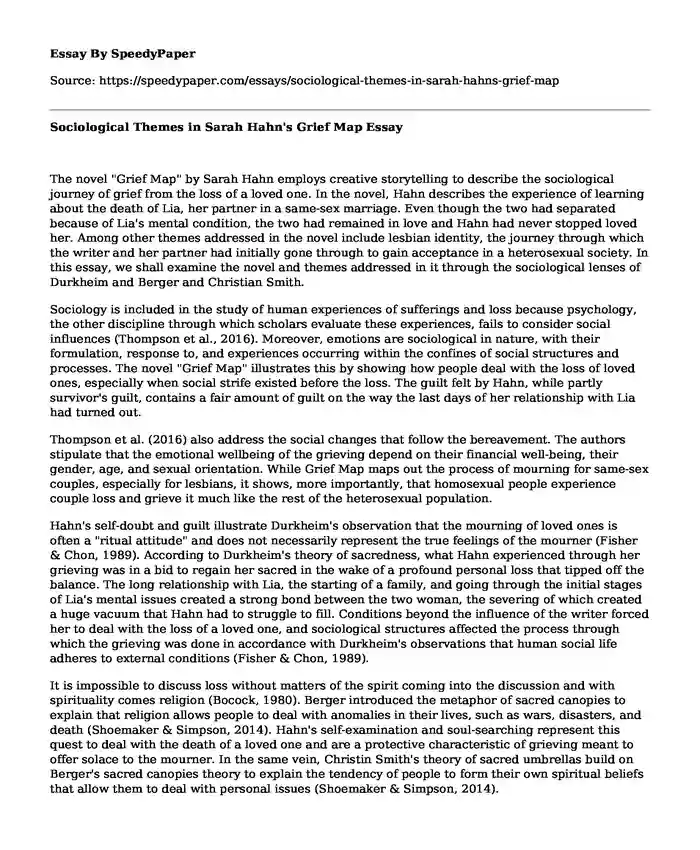
| Type of paper: | Essay |
| Categories: | Sociology American literature |
| Pages: | 3 |
| Wordcount: | 713 words |
The novel "Grief Map" by Sarah Hahn employs creative storytelling to describe the sociological journey of grief from the loss of a loved one. In the novel, Hahn describes the experience of learning about the death of Lia, her partner in a same-sex marriage. Even though the two had separated because of Lia's mental condition, the two had remained in love and Hahn had never stopped loved her. Among other themes addressed in the novel include lesbian identity, the journey through which the writer and her partner had initially gone through to gain acceptance in a heterosexual society. In this essay, we shall examine the novel and themes addressed in it through the sociological lenses of Durkheim and Berger and Christian Smith.
Sociology is included in the study of human experiences of sufferings and loss because psychology, the other discipline through which scholars evaluate these experiences, fails to consider social influences (Thompson et al., 2016). Moreover, emotions are sociological in nature, with their formulation, response to, and experiences occurring within the confines of social structures and processes. The novel "Grief Map" illustrates this by showing how people deal with the loss of loved ones, especially when social strife existed before the loss. The guilt felt by Hahn, while partly survivor's guilt, contains a fair amount of guilt on the way the last days of her relationship with Lia had turned out.
Thompson et al. (2016) also address the social changes that follow the bereavement. The authors stipulate that the emotional wellbeing of the grieving depend on their financial well-being, their gender, age, and sexual orientation. While Grief Map maps out the process of mourning for same-sex couples, especially for lesbians, it shows, more importantly, that homosexual people experience couple loss and grieve it much like the rest of the heterosexual population.
Hahn's self-doubt and guilt illustrate Durkheim's observation that the mourning of loved ones is often a "ritual attitude" and does not necessarily represent the true feelings of the mourner (Fisher & Chon, 1989). According to Durkheim's theory of sacredness, what Hahn experienced through her grieving was in a bid to regain her sacred in the wake of a profound personal loss that tipped off the balance. The long relationship with Lia, the starting of a family, and going through the initial stages of Lia's mental issues created a strong bond between the two woman, the severing of which created a huge vacuum that Hahn had to struggle to fill. Conditions beyond the influence of the writer forced her to deal with the loss of a loved one, and sociological structures affected the process through which the grieving was done in accordance with Durkheim's observations that human social life adheres to external conditions (Fisher & Chon, 1989).
It is impossible to discuss loss without matters of the spirit coming into the discussion and with spirituality comes religion (Bocock, 1980). Berger introduced the metaphor of sacred canopies to explain that religion allows people to deal with anomalies in their lives, such as wars, disasters, and death (Shoemaker & Simpson, 2014). Hahn's self-examination and soul-searching represent this quest to deal with the death of a loved one and are a protective characteristic of grieving meant to offer solace to the mourner. In the same vein, Christin Smith's theory of sacred umbrellas build on Berger's sacred canopies theory to explain the tendency of people to form their own spiritual beliefs that allow them to deal with personal issues (Shoemaker & Simpson, 2014).
From the foregoing, it is clear that Hahn's novel 'Grief Map' gives a remarkably accurate roadmap for dealing with grief. Its advantage over other sociological texts is that it employs creative storytelling of an autobiography kind to give the detailed view of how humans deal with loss.
References
Bocock, R. An introduction to sociology: A reader. Waukegan: Fontana Press, 1980
Campbell, S. H. Grief map. Green Bay: Brain Mill Press LLC, 2017
Thompson, N. et al. The case for a sociology of dying, death, and bereavement. Death Studies, 40, no. 3, 2016, pp. 172-181, DOI: 10.1080/07481187.2015.1109377
Shoemaker, T. & Simpson, W. Revisiting sacred metaphors: A religious studies pedagogical response to the rise of the Nones. Journal of Religion & Society, 16, no. 1, pp. 1-16
Fisher, G. A., & Chon, K. K. Durkheim and the Social Construction of Emotions. Social Psychology Quarterly, 52, no. 1, (Special Issue), 1989, pp. 1-9
Cite this page
Sociological Themes in Sarah Hahn's Grief Map. (2022, May 09). Retrieved from https://speedypaper.com/essays/sociological-themes-in-sarah-hahns-grief-map
Request Removal
If you are the original author of this essay and no longer wish to have it published on the SpeedyPaper website, please click below to request its removal:
- Grass-Fed Beef versus Grain-Fed Beef - Free Essay on Food Safety
- Essay Example on Importance of Nursing Research
- The Killers - Free Essay Analyzing a Classic Noir Film
- White Revolution in Iran, Free Essay for Your Benefit
- History Essay Sample on How China Rebelled Against Japan during World War 2
- Feminism Essay Example: The Personal Is Political
- Free Essay. Dunkin' Donuts Company: History and Introduction
Popular categories




